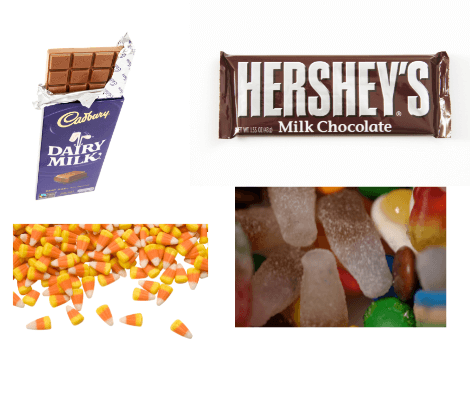We live in a world that prides itself on diversity, and each country has people of all cultures, religions, and backgrounds that make it unique. But, each of us has one thing in common; we love a sweet treat.
It might surprise you to learn that candy has been around longer than most of us, our grandparents, their grandparents - you get the picture.
We can trace candies' roots back to the ancient worlds of Egypt and China. So, in this post, let's take a look at the complete history of candy.
The Beginnings
From the ancient Egyptians and Greeks to the Roman Empire, people have enjoyed sweet treats for thousands of years, but they didn't call it candy. Honey was a sought after food, and many people would take honey straight from the beehive.
We're not sure if the first candy treats were invented to eat it or to preserve flowers, fruits and nuts, but either way, people soon found out that the combination was delicious.
People would soon learn how to manufacture sugar, and while many civilisations would enjoy the benefits of sugar, The Tudors were notorious for many things. Henry VIII left a legacy of death, destruction and division in the country.
But with all the beheadings and religious issues, people often forget about the Tudors love of sugar. So, let's take a look at how they used sugar.
The Tudors & Their Love of Sugar
By the middle ages, people had worked out how to make sugar, which became a staple for the rich. Poor people couldn't afford sugar, but the most powerful in the country would indulge in the sweet stuff regularly.
The early Tudors didn't have the luxury of vast amounts of sugar imported from other lands, but by the time Queen Elizabeth I took the throne, it was beginning to gain traction. Elizabeth herself loved sugar, and it was in wine, food dishes and pretty much everything else.
Funnily enough, the rich also used sugar as toothpaste, so as you can imagine - there were lots of people walking around with black teeth.
While we now know that too much sugar can cause health issues, it's important to remember that our love affair with the sweet stuff originated hundreds of years ago.
The Industrial Revolution
For many years, candy was used as a mixture of sugar, fruits and spices, and people thought it held medicinal purposes. But later years saw a distinct shift in how people viewed candy.
The industrial revolution is one of the most critical periods in history because it defined how we live today. Many manufacturing processes were developed between the late 1700s and early 1900s, including factory machinery.
If we hadn't had an industrial revolution, then things today might look very different. But the revolution paved the way for business, consumerism and gave people lasting careers that meant they could feed their families.
Candy Press InventionIn 1847, the first candy press was invented in response to the increasing availability of candy. While it was previously something only the rich could enjoy, the expanding market meant that sugar was now more accessible to people from all backgrounds.
There was also a distinct shift in how children were treated, with many manufacturers realising that young people were one of the most promising consumer markets around.
Candy presses make it possible for manufacturers to create numerous sizes and shapes of candy at once and then sell it for a profit. Many consumers (especially children) would buy penny candy during this era, as it was cheap but still provided the sugar boost they craved.
The TimelineThe candy timeline shows us some important inventions and occurrences that lead to the candy we know and love today. Let's take a look at some vital moments that defined where we are today.
1847: Joseph Fry makes history by creating the world's first chocolate bar by mixing cacao, sugar and cocoa, then letting it set in a mould. Fry's is still around today, and they're still creating the same delicious chocolate creams!
1848: John Curtis creates the first chewing gum and calls it The State of Maine Spruce Gum.
1854: Whitman's chocolate began to manufacture and sell their first boxes of chocolates. This small step led to the Cadbury company creating a Valentine's Day box of chocolates. The tradition of showing people you care with chocolate gift boxes is still prevalent today.
1881: Reed's Candy Company creates a butterscotch sweet just one year after the ever-popular candy corn first hit the shelves.
1893: The Wrigley's Company introduces its Juicy Fruit and Spearmint Chewing Gum - both of which are still top-sellers today!
1900: A big year for the USA, because The Hershey Company created its first chocolate bar.
1921: Chuckle's brought their jelly style fruit sweets to the scene, which were a huge success.
1923: Not one to be left behind, the Mars company invented the Milky Way bar, which was the first malted chocolate bar with a nougat centre. They then followed it up in 1930 with the Snickers bar (which was named after the family horse).
1958: Something we all remember from our childhoods - candy necklaces steal the limelight for the year 1958, and kids everywhere still wear (and eat) them today.
1963: A year we should all look back upon with love because this was the year Cadbury's created the Cream Egg.
1992: The Mars company introduced the Dove/Galaxy chocolate bar to compete with Cadbury's Dairy Milk. If you're in the UK, then you'll know Dove as Galaxy, where it continues to retain its popularity with Minstrels, Ripple and Galaxy Caramel becoming very popular.
The Wrap Up
So, now you know more about the history of candy, it's clear to see that there's a story with every sweet or bar of chocolate you enjoy. With such a rich history and some candy offerings that have lasted for decades, we look forward to seeing what the future brings chocolate and sweet lovers everywhere.

